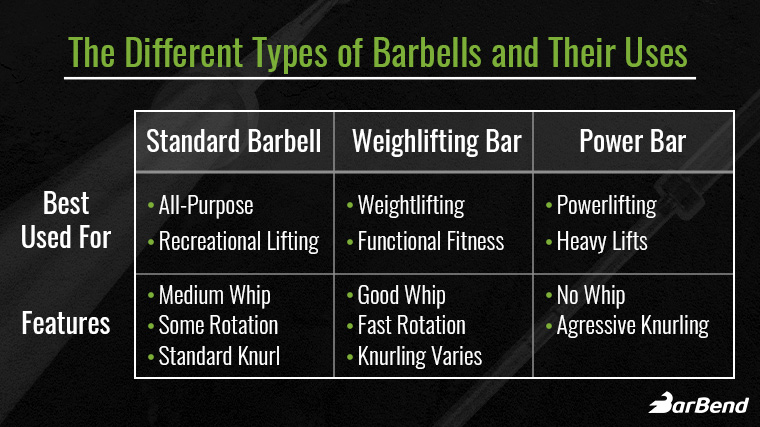A barbell is one of the most versatile pieces of equipment you can find in a gym for building full body strength, right up there with squat racks and weight benches. They’re great tools for lifters of any fitness or strength level and can be used for practically any form of training and exercise. Women’s barbells specifically have a weight of 15kg or 35 pounds, and a shaft diameter of 25mm. If you’ve found yourself on this list, then you might be looking to kick your training up to the next level by investing in a high quality barbell. Don’t worry, we’ve got picks for a variety of home gyms and lifting styles.
Just like any other big purchase, buying a barbell requires some homework to figure out which is the perfect fit for you. There are a ton of different types of barbells for women on the market, which can be confusing and make it difficult to find the one that suits your needs. Our list of the best barbells for women seeks to tone down some of the noise surrounding women’s barbells, so you can focus on getting to lifting as quickly as possible.
Best Barbells for Women
- Best Barbell for Women Overall: REP Fitness Excalibur 15kg
- Best CrossFit Barbell for Women: Fringe Sport Wonder Woman Barbell (Bearings)
- Best Women’s Barbell for the Money: REP Sabre Barbell 15kg
- Best Powerlifting Barbell for Women: Rogue Bella Bar 2.0 Stainless Steel
- Best Women’s Barbell for Weightlifting: Rogue IWF Olympic Weightlifting Bar
- Best Beginner Barbell for Women: REP Sabre Barbell 15kg
- Best Women’s Barbell for Competition: Rogue IWF Olympic Weightlifting Bar
- Best Women’s Barbell on Amazon: Synergee Regional Olympic Barbell 15kg
Best Barbell for Women Overall
Aside from a power rack, the barbell you choose to work out with is likely one of the most important purchases you’ll make in your lifting career. If you’re going to buy one barbell for all of your workouts, it has to be tough enough to stand up to daily use. It also has to be versatile enough to use for a variety of workouts. One such barbell and our pick for best barbell for women overall is the REP Fitness Excalibur 15kg bar.
REP Fitness Excalibur 15kg Barbell
The Excalibur bar is a mixed-use barbell that features a hybrid bushing and bearing system for the sleeves to give a smooth spin. The knurling is a medium to deep cut, so you get a great grip while still being able to use this bar daily without tearing your hands to shreds. The Excalibur is versatile and suitable for powerlifting, weightlifting, and cross-training workouts with dual IWF and IPF knurl marks. The one downside is that this bar lacks a center knurl, so if you’re a powerlifter, you may want to keep that in mind.
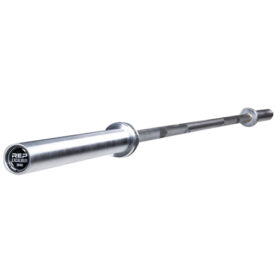
Rep Fitness' Excalibur Barbell can do it all. It's made from 190 ksi tensile strength steel, has a 1,500lb rating, and a hard chrome coating to resist wear and tear. Spin comes from a hybrid bearing a bushing design that will appeal to both Olympic lifters and powerlifters. We especially like the light ribbing on the sleeves to help keep plates in place.
The shaft is 25mm in diameter, in line with almost any other women’s barbell, with a loadable sleeve length of 12.6 inches, and an overall length of 79.1 inches. While the sleeves do feature a slight ribbing to ensure your plates don’t slide off accidentally, we always recommend using collars. This bar is taut too with a static weight rating of 1,500 pounds, and a tensile strength of 190,000 PSI. A hard chrome coating is applied to finish the barbell and help prevent rust, and you’ll get a five-year warranty from REP. The Excalibur is a great pick for nearly anyone except a highly specialized powerlifter, and you can pick one up for $289 before taxes and possible shipping charges — a very reasonable price for this high quality bar.
Who Should Buy the REP Fitness Excalibur Barbell
- If you’re looking for a barbell that can do pretty much any type of training you throw at it, the Excalibur bar was purpose-built to satisfy all disciplines of lifters.
- Athletes who like to change up the way they lift will appreciate the hybrid bearings and dual knurl markings that are good for both powerlifting and Olympic lifting.
- Anyone who needs a solid barbell that will last a long time and not break the bank. For the quality, this bar is priced reasonably.
Who Shouldn’t Buy the REP Fitness Excalibur Barbell
- Athletes who prefer a center knurl for squatting might want to look for a bar with different knurl marks.
- If you’re a weightlifting-specific athlete, you may want to look at other options on this list that may include needle bearings for a more free spinning collar. The hybrid bearings here spin nicely, but not as freely as a weightlifting bar’s would.
- Those who want a bar with a longer or lifetime warranty, or a barbell that will last them a lifetime. The chrome coating here will help this bar last for years, but a stainless steel bar will last forever with proper care.
This barbell is reliable and useful across the board thanks to its high weight rating and multiple knurl marks. Whether you dabble in many different lifting arenas or are looking to specialize in one, the Excalibur can suit your lifting style. A medium to deep knurling is meant to help improve your grip on the bar without digging into your hands too much. The hybrid bearing allows good sleeve rotation while still providing a bit of friction for powerlifting. If you want a bar that’s a Jill of all trades, the Excalibur should be at the top of your list.
Best CrossFit Barbell for Women
CrossFit athletes have a unique set of needs when it comes to a barbell. In the sport of CrossFit athletes do a lot of Olympic lifting, so the bar has to have sleeves that spin well. On top of that, bars in a CrossFit gym take a lot of abuse from slamming, being dropped, and general heavy use so the bar has to be extremely durable. We’ve found a great choice for all your CrossFit needs in the Fringe Sport Women’s Wonder Bar with bearings.
Fringe Sport Women’s Wonder Bar (Bearing)
The bearing version of the Women’s Wonder Bar from Fringe Sport is made to be a tank that can take whatever workout you throw at it and come back for more. Weighing 15kg and featuring an all-black zinc finish to help improve longevity and reduce rust, this bar is great for CrossFitters. The Wonder Bar has a tensile strength of 160,000 PSI, which is lower than many other barbells, but the name of the game in CrossFit is usually repetitions, not maxing out. When you do want to max out though, you can rest assured of the weight capacity of 1,000 pounds. Should something happen to your bar, Fringe Sport offers a lifetime limited warranty, so no need to worry.
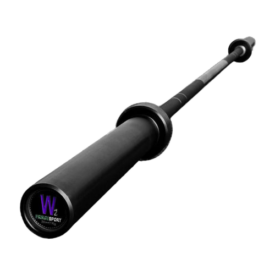
The Fringe Sport Women's Wonder Bar Olympic Barbell offers a strong tensile strength of 160k, yield strength of 199,000, and test strength of 1,000 lbs. The bearings make this bar great for cross-training as the sleeves will spin for weightlifting movements which are commonly featured in cross-training. The zinc coating ensures the bar has some resistance to rust for better longevity.
Another aspect that makes this bar great for cross-training is the stiff whip, which makes cycling the bar easier since you don’t need to wait for the whip to stop or time the bar’s whip. You can line up your hands perfectly on every lift with the dual IWF and IPF knurl markers. You won’t cut your shins when doing cleans or snatches thanks to no center knurling. The Wonder Bar has a more moderate knurl for long sessions when the bar is making a lot of contact with your body. The needle bearings, though they need oiling occasionally, spin much more freely than bushings making them better for Olympic lifting, which is featured predominantly in CrossFit workouts.
Who Should Buy the Fringe Sport Women’s Wonder Bar (Bearing)
- Anyone who does CrossFit-style training. This bar was designed to meet the needs of those athletes from the start.
- Athletes who like lifting with multiple styles — perhaps those who are chasing the 5-lift super total — will love that this bar has dual knurls for both weightlifting and powerlifting.
- Women who do cross-training but also like to train in weightlifting. The needle bearings will give a more free spin to help you turn the bar over quicker and easier.
Who Shouldn’t Buy the Fringe Sport Women’s Wonder Bar (Bearing)
- Athletes who prefer a fully stainless steel barbell will want to look elsewhere as this only comes with a zinc coating.
- Lifters who want a bar that’s dedicated to only either powerlifting or weightlifting might want a less versatile bar that specializes in one discipline or the other.
- Anyone who wants a lower maintenance bar or a bar that’s easier to maintain may want to go for a bar with bushing bearings instead, as needle bearings require maintenance.
For those seeking a barbell to complement their CrossFit workouts and stand the test of time, the Women’s Wonder Bar from Fringe Sport might just be the answer you’ve been looking for. It’s tough, the sleeves spin well, and it was made with CrossFitters in mind.
Best Women’s Barbell for the Money
Some people want a high-quality barbell to train with but are tight on cash, and can’t afford to splurge for a really expensive one. If you take a look around some common resale sites for barbells, you’ll likely find a bunch in varying conditions, but you’re unlikely to find a good quality bar. You may see what are sometimes referred to as beater bars, or bars that you can beat up and not care about since they were cheap, to begin with. For a high-quality barbell that won’t cost an arm and a leg, but commands more respect than a beater bar, take a look at the REP Sabre Barbell.
REP Sabre Barbell
Coming in hot at under $200 before taxes and possible shipping charges, the REP Fitness Sabre bar is a solid, well-constructed barbell that comes ready for action. It features dual IWF and IPF knurl marks, and a weight capacity of 1,000 pounds. This bar does have a much lower tensile strength than other, top-of-the-line bars at 150,000 PSI, but don’t let that deter you. It’s clear where REP cut costs to make this bar as it has ball bearings, which don’t spin as freely as bushing or needle bearings, but they still spin nonetheless.
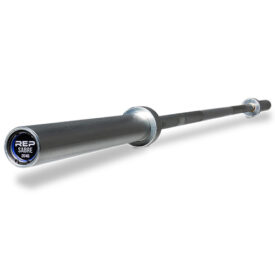
The REP Fitness Sabre Barbell is a multi-purpose barbell that comes in two sizes with the option for both center knurling and a black zinc finish. The bronze bushings allow for use during CrossFit and Olympic style lifts, in addition to traditional lifts.
Weighing 15kg (33 pounds) with a tolerance of one percent and measuring 25mm in diameter, this bar is made to competition size standards for female lifters. The medium-depth knurl offers a solid amount of help with the grip but doesn’t tear up your hands. Contrary to what you’d expect from such an affordable bar, the Sabre bar does include a zinc finish to help protect from rust and wear. The warranty on this bar is only one year compared to the longer warranties that REP offers on their more expensive bars, but you’ll be hard-pressed to find a better-built bar for the same price.
Who Should Buy the REP Sabre Barbell
- If you’re filling up your home gym on a budget, the REP Sabre Barbell’s price point is bound to be attractive.
- Lifters who are tight on money, but still want a barbell that has a finish instead of bare steel to protect it from rusting and unnecessary wear will appreciate the zinc coating on the Sabre bar.
- Athletes who do a lot of different exercises will like the dual knurl markings and medium knurling provided here.
Who Shouldn’t Buy the REP Sabre Barbell
- Olympic weightlifters who need a bar that can accommodate snatches and clean & jerks will want to look for a weightlifting-specific bar that has better bearings to spin more easily.
- Athletes who specialize in powerlifting may want to look for a barbell that comes with a center knurling for more grip during low-bar back squats.
- Lifters who want to invest in a top-tier bar that will last them for many years may want to look at other options on this list. This bar is great for the money, but it’s not an investment piece of equipment.
Incredibly affordable, the REP Sabre Barbell is top quality and sturdy, especially for the price point. Unless you’re a specialized weightlifter or powerlifter, this bar can likely suit whatever type of lifting you’re doing. That’s not to say you can’t do that type of lifting with this bar, it’s just not specifically designed for it. All in all, the Sabre bar is a great value for anyone who needs a high quality, but affordable barbell.
Best Powerlifting Barbell for Women
Powerlifting is a strength sport that revolves around three lifts: the squat, the deadlift, and the bench press — and there are different bars designed for these movements. Powerlifting bars are typically stiffer, have deeper and more aggressive knurling, and bearings that don’t spin as easily (so the lifter doesn’t get off-balance under a heavy weight). If you’re looking for a great choice for a women’s powerlifting bar, let us introduce you to the Rogue Fitness Bella Bar 2.0 in stainless steel finish.
Rogue Bella Bar 2.0 (Stainless Steel)
The Rogue Bella Bar, which is named after Bill and Caity Henniger’s Cane Corso and features her picture on the end caps, has been a mainstay for women’s barbells for over a decade. The new iteration, the Bella Bar 2.0 in stainless steel features upgraded strength with a 200,000 PSI tensile rating. The bar doesn’t have a coating but is still very resistant to wear thanks to the stainless steel construction. Rogue’s knurling on this bar is their standard, medium knurl but it may take a little while to get used to since there isn’t a coating. Some lifters may find the knurling somewhat abrasive at first, but others like the “true” feeling of the steel — it seems to be a matter of personal preference.
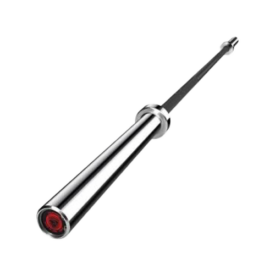
The upgraded Rogue Bella Bar 2.0 in stainless steel is the standard in women’s barbells. It has a tensile strength of 200,000 PSI with the best resistance to rust of any barbell finish thanks to the stainless steel. Dual IWF and IPF knurl marks make sure you get the perfect hand grip every time so you can get to lifting right away.
The sleeves will spin, but not as freely as a weightlifting bar thanks to the composite bushings. In a powerlifting bar, bushings are the optimal choice because they’ll rotate if needed but they do have some resistance to spin, so the weights won’t be spinning while you’re trying to stabilize a heavy squat or bench press.
Who Should Buy the Rogue Bella Bar 2.0 (Stainless Steel)
- Lifters who want to splurge and get a top-quality barbell that will last them a lifetime. Stainless steel bars are more expensive, but they last practically forever if taken care of properly.
- Anyone who competes in powerlifting will appreciate the low whip and bushing bearings that are better for powerlifting.
- Folks who don’t want center knurling on their barbell.
Who Shouldn’t Buy the Rogue Bella Bar 2.0 (Stainless Steel)
- Buyers who don’t want to shell out a lot of money (relatively speaking) for a barbell.
- Powerlifters who want a squat-specific barbell may want to look for a squat bar that tends to be thicker and longer than average barbells.
- Olympic weightlifters or other trainees who need more whip from their bar. This bar is designed to have a minimal whip and less sleeve spin — the opposite of what weightlifters want.
For over a decade, the Rogue Bella Bar has been a top choice for women’s barbells, and it’s easy to see why. The redesigned Bella Bar 2.0 in stainless steel is even better, offering more oxidation resistance to last longer, and a higher tensile strength at 200,000 PSI — among the highest of any women’s bar. You can be confident that you’re getting a top-tier barbell, and Rogue’s customer service is known for being among the best. For a powerlifting bar that will treat you well for as long as you treat it well, you can’t go wrong with the Rogue Bella Bar 2.0.
Best Women’s Barbell for Weightlifting
When selecting a barbell for weightlifting, a few different factors come into play. You’ll need a bar that has great sleeve spin, a decent amount of whip, and is strong enough to stand up to being dropped from overhead daily. Olympic weightlifting is a sport that’s all about timing and power. If you get the timing right, you can combine the oscillation, also known as whip, of the bar with your leg drive and lift a greater weight overhead. Rogue has developed a bar that is IWF-approved and serves up everything a weightlifter wants in a barbell. Meet the Rogue IWF Olympic Weightlifting Bar.
Rogue IWF Olympic Weightlifting Bar
This barbell, nicknamed the Rogue Oly Bar, is precision designed to meet the specifications of the IWF, and the needs of weightlifters of all levels from beginners to world-class athletes. It may sound odd to say, but this bar really is a thing of beauty. The consistent whip and buttery smooth spin of the sleeves thanks to needle bearings combine with a super high tensile 215,000 PSI steel to make a top-tier weightlifting bar.
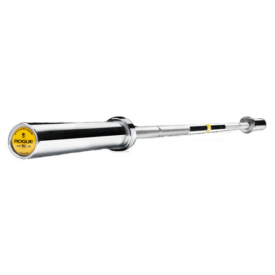
The Rogue IWF Olympic Weightlifting Bar is made to the specifications of the IWF and certified to be used in competition, making it a great bar to practice on so you know what to expect come comp day. The needle bearings provide a smooth spin and the 215,000 PSI still allows for a great whip to help you drive heavy weights overhead.
On the end caps, as well as on the center of the bar, you’ll find IWF branding, proving the specific size and weight requirements that this bar is within. The knurling is uniformly spread across the barbell with no center knurling and single olympic knurling marks. You have 12.5 inches of loadable sleeve length, and a precision 25mm diameter to grip. The Rogue Oly Bar also comes with a lifetime warranty, and if you take care of it, this bar can last that long, too.
Who Should Buy the Rogue IWF Olympic Weightlifting Bar
- Weightlifters who need a training bar that’s approved by the IWF.
- Those who want an incredibly strong bar that can stand up to repeated daily drops and still spin smoothly.
- Buyers who have some extra money to spend, and want a bar that will last them a long time, if properly cared for.
Who Shouldn’t Buy the Rogue IWF Olympic Weightlifting Bar
- Lifters who are on a tighter budget. This bar is incredibly good, but it’s much more expensive than some other bars on this list.
- Athletes who prefer bars with center knurling might want to find another barbell from this list, as this one doesn’t have a center knurl.
- Anyone who doesn’t want a lot of whip in their bar may want to look for a stiffer bar.
If you are a serious competitive Olympic Weightlifter or are seeking to become one, this is the bar for you. You can use the Rogue Oly Bar in training to get the feel for the type of bar you’ll be using during competition, and be able to walk into your next meet with confidence. Rogue designed every aspect of this bar with one group in mind — competitive weightlifters.
Best Beginner Barbell for Women
Beginners have it harder than seasoned lifters in some aspects since the barbell they need should be able to accommodate several styles of lifting. It would be hard to swallow buying a specialized bar for weightlifting and then finding out you really love powerlifting, or vice versa. If you’re looking for a beginner barbell to explore different styles of lifting, then we like the REP Sabre Bar the best.
REP Fitness Sabre Barbell 15kg
When you’re just starting out lifting, you probably don’t know exactly what kind of lifting you’ll like doing the best. You might even be excited to test out different styles — which means you’ll need a barbell that’s versatile enough to support that. The REP Sabre bar has dual grip options for powerlifting and Olympic weightlifting with moderate to medium knurling so you can gradually build up the toughness of the skin on your hand over time. The grip options are particularly helpful for beginners since they can help ensure you use the same grip every time and give you more reference points.

The REP Fitness Sabre Barbell is a multi-purpose barbell that comes in two sizes with the option for both center knurling and a black zinc finish. The bronze bushings allow for use during CrossFit and Olympic style lifts, in addition to traditional lifts.
This bar does have a lower tensile strength of 150,000 PSI, but that shouldn’t be a problem for beginners since the weight you’ll be moving will likely be lower than an advanced lifter. If you are super strong though, this bar has a weight rating of 1,000 pounds. The Sabre should last a few years even though it’s more affordable than a lot of other bars, priced at just under $200 before taxes and possible shipping charges. The longevity will come thanks to the zinc finish, which helps to prevent rust and wear.
Who Should Buy the REP Fitness Sabre Barbell 15kg
- Anyone who needs a multi-use barbell that can accommodate multiple styles of lifting.
- Those who want a more cost-effective bar since they’re just starting out lifting, and don’t know if they want to get a more specialized bar yet.
- Buyers who want a less abrasive knurling to ease their hands into lifting with knurled barbells.
Who Shouldn’t Buy the REP Fitness Sabre Barbell 15kg
- Lifters who are specialized in powerlifting or weightlifting may want a bar that is for that specialized style of lifting.
- Those who are lifting a lot of weight and need a bar with a higher tensile strength rating.
- Athletes who want a barbell with center knurling. You won’t find it here.
The REP Sabre bar is strong and well-priced. It also comes with multiple knurl marks to help beginners find their hand position more easily and more consistently for different lifts. For a beginner, you can’t ask for anything more from a bar that can last you through your first few years of training until you decide what type of lifting you like best.
Best Women’s Barbell for Competition
When it comes to competing in a sport, you generally want your practice to replicate the event as closely as possible. This serves to better prepare you for what the competition will bring, and improve your confidence should things inevitably go awry. Those who compete in weightlifting know the type of equipment they will be lifting on and should practice, if feasible, with our pick for best competition barbell, the Rogue IWF Olympic Weightlifting Barbell, or Rogue Oly Bar for short.
Rogue IWF Olympic Weightlifting Bar
Weightlifting bars have a specific set of dimensions that they can be. For women’s weightlifting, they must weigh 15kg, have a diameter of 25mm, and have an overall length of six and a half feet (or two meters). The governing body of international competition for weightlifting is the IWF and they certify certain barbells that meet these specifications. The Rogue IWF Oly Bar meets them and is a great option to not only train on but it’s approved for competition too.

The Rogue IWF Olympic Weightlifting Bar is made to the specifications of the IWF and certified to be used in competition, making it a great bar to practice on so you know what to expect come comp day. The needle bearings provide a smooth spin and the 215,000 PSI still allows for a great whip to help you drive heavy weights overhead.
The Rogue Oly Bar features needle bearings for a sleeve that spins smoother than almost any other type of bearings. You will have to shell out some coin for this bar as it’s priced at $545 before taxes and possible shipping charges, but it’s the real deal and the best option for those who compete at (or want to compete at) a high level in Olympic weightlifting. The tensile strength on this bar is 215,000 PSI — higher than almost any other bar out there. If you like to time your jerks with the oscillation of the bar, the Rogue Oly Bar is quite whippy and will allow you to do so. You’ll be hard-pressed to find a better competition-approved bar around the same price — most comparable ones are around double.
Who Should Buy the Rogue IWF Olympic Weightlifting Bar
- Women who want to compete or actively compete in weightlifting. There’s nothing quite like having the real thing to train and compete on.
- Athletes who want the best bar they can buy at a reasonable price for the high quality. There are few bars better than this in the price range.
- Anyone who likes a bar with a strong whip and freely spinning sleeves will appreciate the engineering of the Rogue IWF Oly Bar.
Who Shouldn’t Buy the Rogue IWF Olympic Weightlifting Bar
- Lifters who don’t specialize in weightlifting, even if they do weightlifting movements, may want to look for a multi-purpose bar instead.
- Anyone who is on a tighter budget may want to look for a more cost-effective bar. This bar is reasonably priced for a competition bar, but it’s still expensive.
- If you want a center knurling to secure your back squats even closer, you might want to look for a bar that has one, as this bar does not.
If you’re looking to make your way to the upper echelon of Olympic Weightlifting, you’re going to need the right equipment to get there. Beyond a solid pair of wrist wraps, a belt, and maybe straps, you’ll need the right barbell. With Rogue’s IWF Olympic Weightlifting Bar, you’ll know what to expect in competition, and be more confident going into meet day.
Best Barbell on Amazon
Amazon can be tough to navigate when it comes to finding what you’re looking for, especially when it comes to finding fitness equipment. How can you tell what reviews to trust, or if a company will stand behind their product should something go wrong? Luckily, we have a great option here for you with the Synergee Regional Olympic Barbell.
Synergee Regional Olympic Barbell 15kg
Synergee clearly made this barbell to impress. The Regional bar features a higher-than-average 190,000 PSI tensile strength and 1,500 static weight capacity. Needle bearings, better for freely spinning collars, are featured in the sleeves with a moderate knurling that gives a solid grip without tearing up your hands. There are dual knurl markings for powerlifting and Olympic lifting, allowing you to get the correct hand placement each time.
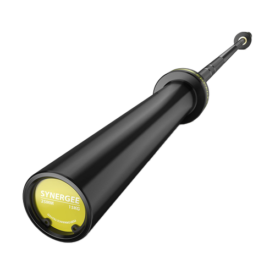
The Synergee Regional Olympic Barbell in 15kg weight is a budget bar but don’t let that fool you. This bar has all the features of a more expensive bar with needle bearings, a high 190,000 PSI tensile rating, and dual knurl markings.
The price is attractive too, especially for the features, coming in at around $199.95 before taxes and possible shipping charges. Synergee also offers a 100 percent satisfaction guarantee and states that they’ll send you a new product for free if you’re not satisfied. There is only a one-year warranty on this bar though, so if you plan on using the bar for many years, you will want to be mindful of that. They even got the dimensions right for Olympic lifting standards with a 25mm diameter and 15kg weight for a bar that offers good whip and durability. If you want to get a new bar fast, you can order this one with Prime shipping.
Who Should Buy the Synergee Regional Olympic Barbell 15kg
- Lifters who want a versatile bar for multiple disciplines of lifting will appreciate the dual knurl marks.
- Consumers who are looking for a high-quality barbell, but don’t have a lot to spend on one.
- Trainees who want to get their barbell quickly. Amazon Prime shipping is available for this bar.
Who Shouldn’t Buy the Synergee Regional Olympic Barbell 15kg
- Buyers who are looking for a competition-approved barbell will want to check out the other options on this list.
- Powerlifters who want a bar with more aggressive knurling or a center knurl for a better stick during squats.
- Those who need a stiffer bar with less whip may want to get a different bar. Synergee made this bar to have a good amount of whip.
This bar has specs that are as good as the ones for bars that are double the price. That said, they do only offer a one-year warranty, but the customer satisfaction guarantee gives a good idea of how they feel about the quality of their product. You can get some serious lifting done with this bar, and the option for Amazon Prime shipping is just the icing on the cake.
Benefits of Barbells for Women
Barbells made specifically for women aren’t a marketing trick for companies to make more money, like women-specific products are in many industries. There are real differences with tangible benefits in women’s barbells. The bars feature a slightly smaller diameter, lower standard weight, and can help you prepare better for competition if you’re planning on competing. We’ll go over each of these benefits in more detail below.
Diameter
In spite of not passing the Bechdel Test, we can reference the difference in the diameter of women’s barbells compared to men’s. (1) The typical barbells you’ll find in commercial gyms are men’s barbells, which most people will be familiar with and they are generally between 28mm and 30mm in diameter around the shaft.
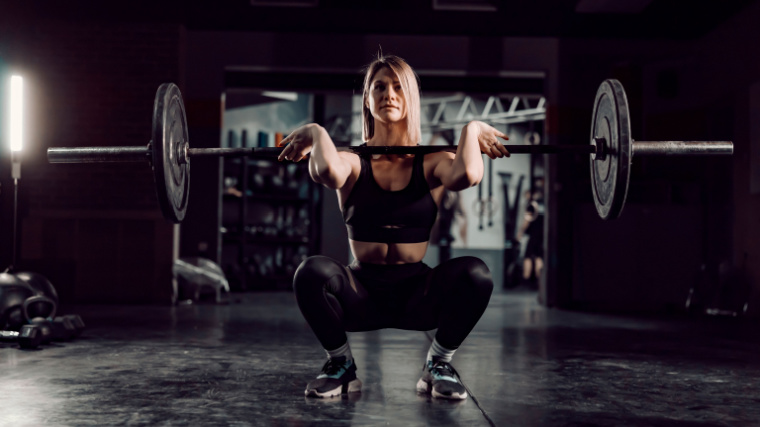
The smaller diameter is traditionally thought to accommodate for women having smaller hands, which is especially important in weightlifting when lifters utilize a hookgrip. The reasoning may also be to allow for more whip of the barbell and to shave off the extra weight so that the barbell can be the appropriate weight.
Weight and Length
Women’s barbells have a different standard weight than men’s. While standard men’s barbells weigh either 20 kilograms or 45 pounds, women’s bars weigh either 15 kilograms or 35 pounds. This can be especially helpful for beginners who may find a 45-pound barbell too heavy to perform certain exercises.
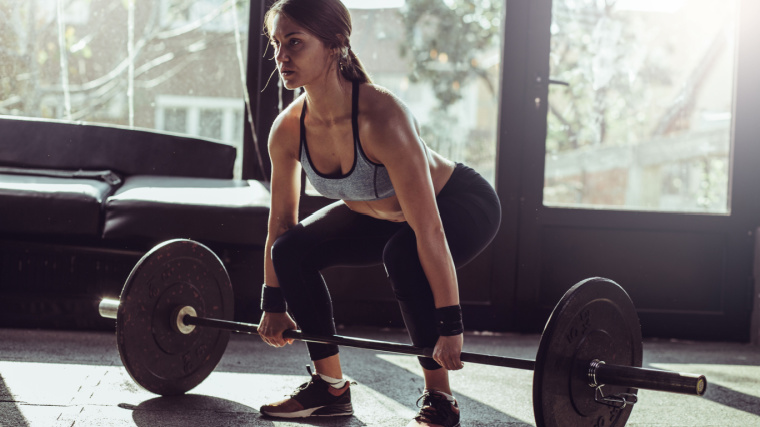
Women’s barbells are also shorter in overall length compared to men’s bars. Men’s bars are typically seven feet in length with some exceptions for specialty bars, whereas women’s bars are generally six feet in length. The shorter length allows for better control of a barbell, especially for those with narrower upper bodies and shoulders for the bar to rest on during squats and other loaded movements.
Prepare for Competition
If you plan on competing in weightlifting or powerlifting, then you’ll likely be using a women’s bar during competitions. Training on a men’s bar, which has a different diameter and therefore, a different center of gravity (as well as less oscillation), and then competing on a women’s barbell is a recipe for a bad meet. To best prepare yourself for how everything will feel when you step on the platform, it’s a good idea to train on a barbell that is as close to what you’ll use to compete.
How We Chose the Best Barbells for Women
There are a lot of factors to consider when picking the best barbells, like what their purpose is, how durable they are, and their price point. We break down how we chose our picks below, and how we rank each aspect of a women’s barbell.
Training Style
The first thing to consider when choosing or ranking a barbell is what type of training the bars are designed to accommodate. There are a ton of specialty or niche barbells out there designed to train a specific aspect of sport, like multi-grip bars, trap bars, and others — for the purposes of this list we just looked at women’s conventional barbells.
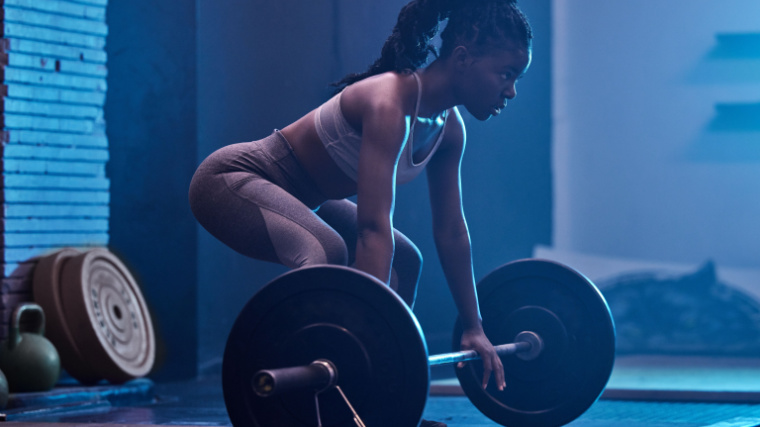
[Read More: The Best Upper Body Exercises and Workouts]
We looked at what type of training the bar is designed for, and what aspects of it are suited to that type of lifting. For example, if a company advertises a barbell as a women’s weightlifting bar, but uses bushings instead of bearings, so the sleeve doesn’t spin as well, that bar may not rank as highly. Conversely, a powerlifting bar with needle bearings may not rank highly, even though needle bearings are more expensive, because the sleeves will spin too much, and be too easily damaged from a heavy deadlift with metal plates.
Durability
Durability is another important factor to consider when ranking women’s barbells. When you buy a bar, you’ll want it to hold up over time and last at least a few years for more cost-effective ones, and perhaps a lifetime for more expensive women’s bars. A lot of durability comes down to the finish of the bar, which is usually either a coating of zinc or cerakote, or non-coated stainless steel. Bare metal bars are going to rust much faster than coated or stainless steel bars, and thus, will rank lower. Stainless steel or cerakote-coated bars, while more expensive, will rank higher for durability.
Price
Once we’ve established the other factors of a women’s bar, we look at the price to see if it’s in line with the features of the barbell. Certain types of bars command more money based on reputation and name alone as they have established high quality. Other newer companies have to show that they put all the right parts into their bar, and made it properly to match the price point they’re charging for a better ranking in our book.
How Much Do Barbells for Women Cost?
Women’s barbells are usually priced fairly well and don’t run high up into the stratosphere of barbell prices, unless you’re interested in a specialty barbell or a sport-specific one. Dedicated weightlifting and powerlifting bars, as well as specialty unisex bars will usually cost more than a multi-purpose barbell.
| Best Barbell for Women Overall | REP Fitness Excalibur 15kg | $289 |
| Best CrossFit Barbell for Women | Fringe Sport Wonder Woman Barbell (Bearings) | $239 |
| Best Women’s Barbell for the Money | REP Sabre Barbell 15kg | $199.99 |
| Best Powerlifting Barbell for Women | Rogue Bella Bar 2.0 Stainless Steel | $330 |
| Best Women’s Barbell for Weightlifting | Rogue IWF Olympic Weightlifting Bar | $545 |
| Best Beginner Barbell for Women | REP Sabre Barbell 15kg | $199.99 |
| Best Women’s Barbell for Competition | Rogue IWF Olympic Weightlifting Bar | $545 |
| Best Women’s Barbell on Amazon | Synergee Regional Olympic Barbell 15kg | $199.95 |
The floor for a high quality women’s barbell is around $200, and while technically the sky’s the limit, the highest price you’ll see on this list is around $550 for a specialized weightlifting barbell. Women’s barbells follow a very similar price distribution as the ones on this list where the cheapest you might find a top-notch bar for is around $200. There are also a few mid-range barbells with extra features (like improved bearings or different knurling) that cost a bit more in the $300 to $400 range. Then sport-specific powerlifting and weightlifting bars will cost anywhere from $500 to $1,000.
What to Consider Before Buying a Women’s Barbell
Most non-gymgoers will look at a bunch of barbells and have trouble telling the difference, and even some seasoned lifters may not know all the differences between barbell types. That’s why we’ve done the homework to help you know what to look for and consider before finally making your purchase. You’ll want to consider the type of barbell you’re buying, the knurling, the strength, and the whip of the bar, among other details. Read on to see a breakdown of each consideration.
Types of Barbells
The market is flooded with different types of barbells, and it can be quite daunting to sift through them all. Luckily we’ve done that in this list, and we will show you how.
There are three major categories of women’s barbells that are relevant to strength athletes and recreational lifters. They are standard barbells, which are sometimes called cross-functional or multi-use bars, weightlifting barbells, and power barbells. These three categories each have different purposes and features to match a specific set of needs. Check the image below to see some highlighted main differences.
Aside from the big three types of barbells, there are a plethora of other specialty bars for each niche that are meant to target specific movements, exercises, or muscle groups. We’ve taken the liberty of listing a few of the major types below along with their best practice uses.
Men’s Bars
Men’s bars are made with weights of 20kg or 44 lbs and have a diameter of 28mm. Many women choose to train with a men’s barbell because that’s all they had when they began lifting, and they’re comfortable with it, or because the thicker diameter feels more comfortable. If you plan to compete in powerlifting or weightlifting, you’ll likely want to train on a women’s barbell though to replicate the competition better.
Deadlift Bars
Deadlift bars are often a smaller diameter than men’s barbells, and thus, offer a better whip to bend the bar off of the floor. They have some of the most aggressive knurling of any barbells and are best suited for deadlifts, as their name implies.
Squat Bars
Squat bars are the antithesis of deadlift bars in so far as they are made with little to no whip, so you don’t get driven down from a mistimed squat. They also are usually thicker in diameter, often over 30mm, and have knurling across the entirety of the barbell, except for a few knurl marks for hand placement and centering.
Hex Bars
A hex bar, more commonly known as a trap bar, is an alternative to the conventional straight bar and is used predominantly for rehabilitation and teaching hip hinging patterns, but can be used by non-strength sports athletes to almost entirely replace a conventional barbell.
Knurling
The knurling of a barbell is the etched, abrasive portion with an almost sandpaper-like texture that covers either side and sometimes the center of the barbell. It’s extremely important for a few reasons, most of which is getting a better grip on the bar. Try to grab a bar and pick it up holding the smooth portion, then try again on the knurled portion, and you’ll immediately understand its importance.
Knurling is also a helpful tool for getting your hand grip correct and lining up your position on the bar. Each side of the bar has a ring where the knurling breaks called a knurl mark. Sometimes barbells have two if they’re marked for weightlifting and powerlifting. These can be incredibly helpful additions to a women’s barbell to accurately center your body on the barbell and find your proper hand positioning.
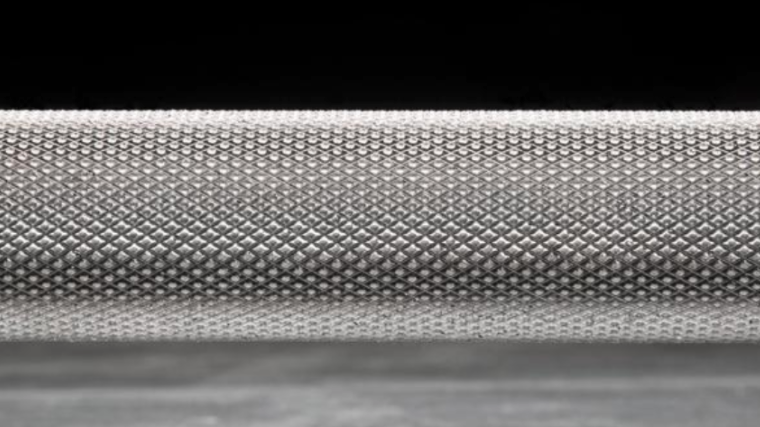
The knurl patterns are specific to certain sports. For example, Olympic bars will generally have a smooth center without knurling so your neck and shins don’t get torn up during cleans and pulls — though you can find women’s Olympic barbells with center knurling. Deadlift and powerlifting women’s barbells typically have a more aggressive knurling pattern and center knurl for better grip.
Bar Diameter (Grip Diameter)
The diameter of a barbell can easily be overlooked, but almost always women’s barbells will have a 25mm diameter unless it’s a specialty bar like a squat or trap bar. Men’s barbells will usually be anywhere from 27mm to 29mm for conventional bars. Make sure you’re getting the right diameter bar for you, and your chosen sport or activity.
Strength
Tensile strength, sometimes called yield strength, can be a great metric to correlate to a women’s bar’s overall strength and long-term durability. It can also let you know how resistant a certain barbell is to breaking or cracking prematurely. Almost all reputable manufacturers will list the tensile strength of their barbell, and we’d recommend staying away from any that aren’t willing to disclose this information as that barbell will likely break down quicker than it should.
Tensile Strength
A women’s barbell’s tensile strength is one of the most important and widely used aspects to showcase a bar’s strength and durability. Tensile strength is measured in PSI or pounds per square inch, much like a car tire’s air pressure, and it basically tells you how much pressure you can exert on a bar before it becomes permanently deformed or suffers a catastrophic failure. High tensile strength means a better and more high-quality women’s barbell in general.
Here are some common tensile strength ranges that you’ll find on women’s bars.
150,000 PSI > — If a bar has less than 150,000 PSI it’s okay for beginners, but you may want to look at a higher tensile strength barbell that will likely last a longer time if you have some extra money to do so.
150,000-180,000 PSI — A women’s barbell in this range is going to be solid for years, and suitable for most people to use, even advanced lifters. This is where you’ll find most of the barbells from major manufacturers to be.
180,000+ PSI — Women’s bars in this range are generally among the best and can last a lifetime with proper care. They’re tough and durable and resistant to bending so long as you treat them well. These will also usually cost the most money and you’ll often find specialized bars like Olympic weightlifting and powerlifting women’s bars in this range.
Yield Strength
Yield strength, most often called weight capacity or static capacity, is basically how much weight you can load onto the barbell before it becomes deformed and bends permanently. Many companies don’t list their yield strength because so few people will ever get there — common yields for women’s barbells are in the 700-pound to 1,500-pound range. As long as you don’t mistreat your barbell by dropping it on safety pins, or slamming it with metal plates from overhead, you’ll likely be fine.
Whip
The whip of a women’s barbell is a very important aspect and is usually greater than that of a men’s barbell due to the thinner diameter of the shaft. Whip is how much the bar will flex or bend during the course of a lift without losing its straight line shape, and bar whip is somewhat how we got the namesake of our website “BarBend”.
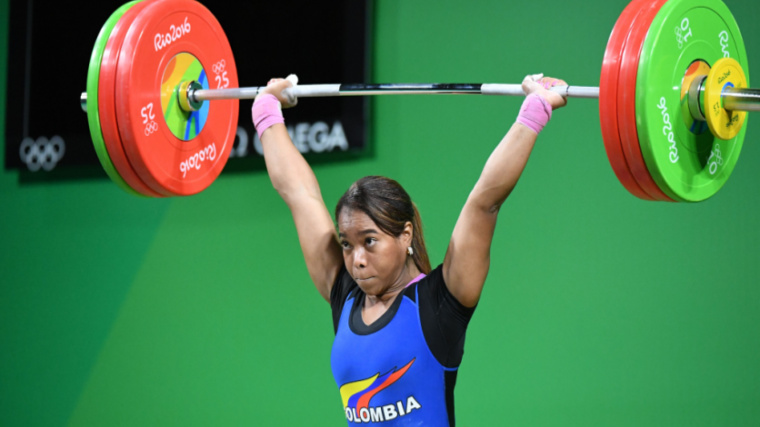
Whip isn’t generally a big concern for most recreational lifters or beginners, but can become important as you get stronger and develop into your lifting career. Many companies have a short blurb that simply states “good whip” or “no whip” depending on the type of bar.
Warranty
When you purchase a brand-new women’s barbell it will almost always come with some form of warranty. Be cautious as the warranty only usually covers the original buyer so if you’re buying a barbell second-hand the warranty will be voided.
Commonly, warranties cover manufacturing defects and issues with the design or parts for anywhere from one to five years on average, but some companies offer lifetime warranties. Almost all warranties are voided if you’re negligent with your bar, like leaving it exposed to the elements or dropping it on safeties while it’s loaded with weights.
Raw Materials and Finish
Almost every type of barbell is going to be made from steel, but as we discussed earlier, that steel can vary leading to differences in quality and tensile strength. Thankfully, barbells only have a few other parts to be mindful of, such as the bearings or bushings that allow the sleeve to rotate and the finish of the bar.
Bushings are a type of bearing usually used for slower lifts like powerlifting. Among bushing bearings, bronze is usually the best choice. Needle bearings offer a better spin to the sleeves of the bar, and are most commonly used in Olympic weightlifting women’s bars.
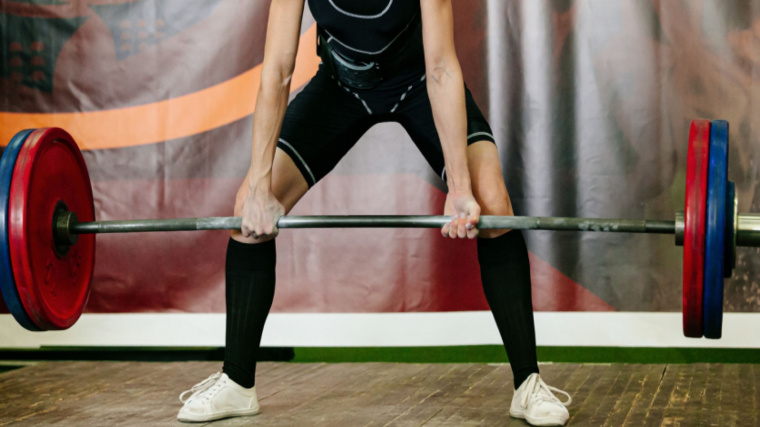
The finish of a bar is important in knowing how resistant to oxidation, or rust, and scratching the barbell will be. Among the most expensive are stainless steel and cerakote, but they also offer the best protection. Lower-cost options include bare steel and budget chrome, which offer the least protection. In the middle, there’s the happy medium and the most common option, zinc.
Caring for your Barbell
You should put as much consideration into caring for your barbell as you do in choosing it. If you want to keep your women’s barbell in the best condition, there are a few things to do somewhat regularly.
You’ll want to clean the chalk and any other mess like skin, sweat, and oils after every session with a brush. Oiling your bar is also a good idea to do every other week or monthly depending on the type of bearings — needle bearings need more care. Leave the oil overnight to sink in. Always check with the manufacturer to see what their recommended best cleaning practices are for your women’s bar and keep up with it. Some more budget-friendly women’s bars may need more frequent cleaning because they are more susceptible to rust, but others, like stainless steel bars, may only need a good cleaning every few months.
Final Word
A women’s barbell is an incredibly versatile tool and perhaps the most versatile tool there is for lifting. It can help you get strong, flexible, and explosive all on its own with the addition of some weight plates. Prices for women’s bars can range widely, from under $200 all the way up to over $1,000 for some competition barbells. The features can vary quite a bit as well, so ensure that you’re clear on what you need in a bar before you buy.
Once you get your bar, take good care of it, and it will take good care of you. Setting up a biweekly or monthly cleaning day can help you stay organized, so you don’t put off maintenance. You’re going to be spending a good chunk of cash on the bar, so you want it to last. If you buy a high quality women’s bar, like one of the ones on this list, and take good care of it, you may never need to buy another barbell again — and you might even make some great gains along the way.
FAQs
What qualities make a great women’s barbell?
The qualities that people look for in a barbell will largely depend on your budget and the sport you participate in or are looking to participate in. A great barbell for a female powerlifter is usually one with a deep cut heavy knurling, center knurl, and stiff whereas a women’s weightlifter will focus on sleeve spin or bearing type, durability from being dropped, and a more moderate knurling. For everyone else, something in the middle, or a multi-purpose bar is likely going to fit the bill the best.
What is the best women's barbell?
There are a ton of women’s barbells on the market now with options for nearly every sport and type of lifting. Our favorite is the REP Fitness Excalibur 15kg Barbell. Not only does it sound cool, but it’s an incredibly well-made barbell at a bargain price. It was purposefully made to accommodate any type of lifting you want to do, and it has a high weight capacity, so you can grow with it instead of replacing it with a tougher bar quickly.
How much do women's barbells cost?
Women’s bars follow a familiar price range precedent that was set by men’s barbell vendors. The most cost-effective barbells that are still made well are generally around $200 to $300 while higher-end bars may cost between $300 and $500. Over $500 is where the specialty barbells find their home with bars specifically designed for powerlifting, weightlifting, or some other purpose.
Why should I buy a women’s bar instead of a men’s bar?
If you’re going to compete in a strength sport, or plan to compete in one then it’s a good idea to practice how you’ll compete. In weightlifting and powerlifting, they use women’s 25mm, 15kg (35 pounds) bars as the standard. It would feel mighty odd to go from training with a larger and less whippy bar to a smaller bar with more whip. Aside from those competing in strength sports, it’s not necessary, and if you already have access to a men’s bar and don’t want to spend the money, then stick with that. Just be mindful that if you ever think about competing, it’d be best to pick up a women’s bar like the ones on this list.
Does how much the barbell whips matter for women?
Yes, and more than you might think. Women’s bars tend to have more whip than men’s bars thanks to the smaller diameter of the shaft. There’s a reason powerlifters like stiffer bars and weightlifters prefer whippier bars. For a powerlifter, bar whip may be detrimental to their lifting if they, say, are squatting and hit the bottom of a squat and the bar oscillation (whip) hits after they start to drive up, it can force them to fight through it, and make the lift even harder.
Weightlifters on the other hand, tend to use the bar whip to their advantage — especially when doing jerks. They dip down and can time the bar whip just right to get some extra free upward momentum combined with their leg drive to power the weight upwards to make the lift. A great example of a weightlifter who gets the most out of a women’s bar’s whip is Lydia Valentin.
References
- https://bechdeltest.com/. Retrieved 30 January, 2025. N.A.
